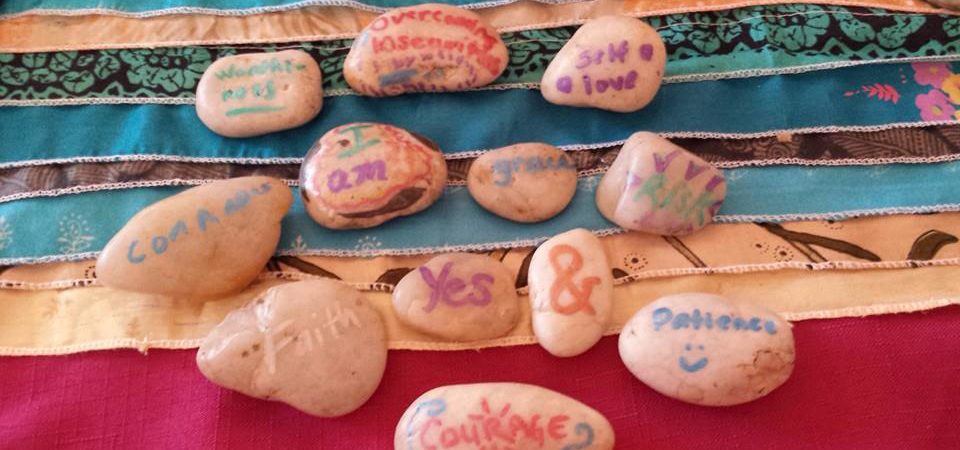More than Words
November 8, 2016A lot of times, prayer can seem like something that is done with words and thoughts rather than action. For people who like to use their hands or bodies, it can sometimes be hard to connect to the idea of prayer, and this is doubly true when we are praying with or as children. But around the world, in many cultures and faith, there are prayers that are made with our bodies, with movement or by creating something with our hands. A couple of years ago, for a Children’s Chapel at the church I served as a religious educator, I created a chapel service on prayer, and set up many “prayer stations” to do different types of actions and creative activities in a prayerful way. Before we began, we talked about the question, “What is prayer?” We also talked about Anne Lamott’s idea that there are three essential prayers (Listen to NPR story):
Help
Thanks
Wow
The children and adults gathered for chapel had so many ideas of different ways to pray, and we talked about them all. We decided that most kinds of prayers would be one of these three things, but maybe not all. We also talked about how some prayers, like meditation, dance, art and yoga don’t always require words, just awareness or feeling. As Unitarian Universalists who find meaning in many sources, we are lucky to have a big definition of what prayer can look like and mean!
The truth is, so much of our world is geared toward people who learn best from seeing or hearing, and even our ideas of prayer can be limiting to those who learn best by doing or creating with their hands. (In the education world, we call this type of learner a kinesthetic learner.)
So these prayer stations are not just for children or families with children, but for anyone who connects to the world by making or moving. If you are interested in doing some kinesthetic prayers, or prayers using art, your body, and physical items to interact with, here are some of the prayer stations I created for that chapel service. I recreated this service later for a large multigenerational group as a UU camp later that year, and the (mostly adult) gathering spent over an hour interacting with these stations, so even if there aren’t children in your life, I encourage you to try them out!
Prayer Beads
What is important in your life? On your mind? Changing? Put a bead on your prayer bracelet for each thing on your heart and carry it with you.
UU minister Erik Walker Wikstrom gives a more formal process for creating your own UU prayer beads in his book Simply Pray. Rev. Joanna Fontaine Crawford, former CLF learning fellow, made a video about this prayer form:
Gratitude Window
Using Sharpies and a piece of wax paper, create a stained-glass window effect by drawing lines in a random pattern or tracing a design with a black marker. Take turns coloring a square or two to represent the things you are grateful for. If you want to make something permanent, you can also use this technique on glass jars or even old windows!
Reflection Corner
Create a place to be quiet with your thoughts, maybe in a corner of a room in your house. Make it comfortable with pillows and blankets, and include a mirror. When someone needs time to think, they can go and look at their reflection in a mirror, and listen to the still, small voice inside.
Praying in Color
Write a word, a name, an idea. Trace around it in color after color, and concentrate on that word. Let your energy flow into the word and into the color. This can also be done with other types of drawing and doodles. (Many thanks to Rev. Scottie McIntyre Johnson for teaching me about this form of prayer.)
Buried Treasure
Fill a shoebox top or pie tin with rice. (You can color it with food coloring, or scent it with essential oils if you like!) In the rice, place some small shiny rocks, plastic gems, or other precious items. (Here’s an example.) Use a stick or fingers to move the rice and gems in different patterns meditatively. Breathe deeply, and relax!
Change Stones
Where have you come from? Where are you going? Choose a rock and write a word on each side: one to represent where you have come from, and one to represent where you are going. (Use a paint pen to make the words permanent.) Carry it with you, place it on your altar, or bury it in the garden; what you choose to do with this prayer is up to you!
Intention Tree
Using an indoor tree (real or artificial) or gathered branches, take gift tags or other paper to write your intentions—or the things you are grateful for!—and tie them to your family’s tree. Here is a place to share who you want to be in the world, and what you want for your family. This is a great example of a “thankful tree”.
Mandalas
Another way of praying in color, mandalas can soothe and quiet the mind. You can find many templates online to print out, as well as coloring books full of design! Choose some colors and a design, and calm your mind as you color.
So . . . how do YOU pray?
- Show Some Love - May 17, 2017
- Ways to Wait - November 30, 2016
- More than Words - November 8, 2016
Comments are closed.
Support the CLF
Can you give $5 or more to sustain the ministries of the Church of the Larger Fellowship?
If preferred, you can text amount to give to 84-321
Newsletter Signup
About
Quest for Meaning is a program of the Church of the Larger Fellowship (CLF).
As a Unitarian Universalist congregation with no geographical boundary, the CLF creates global spiritual community, rooted in profound love, which cultivates wonder, imagination, and the courage to act.
Contact
Church of the Larger Fellowship Unitarian Universalist (CLFUU)
24 Farnsworth Street
Boston MA 02210




Sarah… Thank you for such a beautiful article. I enjoyed it very much. I’m new to the UU faith after many years of activity and separation from another church. There is no congregation locally so I appreciate this bit of devotion.
Thank you so much for this! I will be making myself some prayer beads, and trying some of the other activities with my grandson over the holidays! I very much appreciate the gentle manner in which you have helped to broaden my ideas about how to pray and given me some tools to deepen my spritual practice.